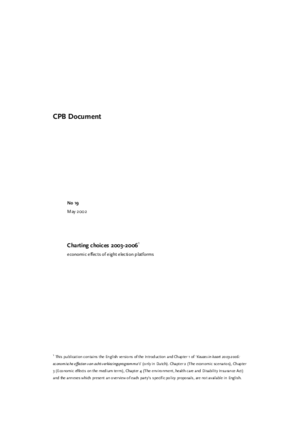Charting choices 2003-2006: economic effects of eight election platforms
Analysis of economic effects of Dutch election platforms
In 2001, all eight political parties then represented in Parliament asked the CPB to analyse the economic effects of their election platforms: the Labour Party (PvdA), the People's Party for Freedom and Democracy (VVD), the Christian Democratic Movement (CDA), Democrats 66 (D66), Green Left (GroenLinks), the Christian Union (ChristenUnie), the Socialist Party (SP) and the Reformed Political Party (SGP).
The analysis of the economic effects of the election platforms is a tradition since the runup to the general elections in 1986. The process is unparalleled in the world. The CPB analysis contributes to a better understanding of the contents of the election platforms and their mutual comparability in several ways. The summary also makes clear why it is useful and what its limitations are.
Among the wider public the CPB analysis is invariably described as a 'calculation' of the election platforms. The public's interest in the analysis focuses on how the quantitative results for the various parties compare, and often for only a few variables. The outcomes are then almost treated - without justification - as performance scores. However, the purpose of the report is to illustrate the choices which the various parties are making. A good result on one variable invariably means a lower score on another variable.
Election platforms deal with proposed choices. Of course, everyone wants to take measures that cost nothing or have no down sides. But in practice everything has a price tag. Therefore, political parties have to make choices on the dilemmas they face. A party cannot raise public spending, cut taxes and reduce the public debt all at the same time. Or what about the dilemma between income solidarity with benefit recipients and stimulation of participation in the labour market by reducing the replacement rate, that is, the ratio between the benefits for those out of work and the net pay of those in work? Positive economic effects can be accompanied by negative environmental effects. With this analysis CPB Netherlands' Bureau for Economic Policy Analysis wants to set out the choices which the political parties propose in their election platforms. This will reveal the various preferences they have.
Important elements of the analysis are the summaries of the budgetary, macroeconomic and purchasing power effects of the election platforms. With regard to the budgetary effects, the CPB looks at the implications of the proposed measures for income and expenditure of the public sector as a whole, which includes the central government budget in the narrow sense, as well as the budgets for social security and health care.
The macroeconomic effects relate to the implications for the Dutch economy: output, employment, consumption, earnings, inflation etc. Purchasing power effects are not easily expressed in a single figure, because the implications for different types of households vary widely. Hence, in this context dot diagrams and a juxtaposition of the relevant figures for the various groups are presented.
Beside the quantitative information, the publication also gives a qualitative analysis of proposals to reform the health care sector, and a more detailed analysis of the proposals related to the Disability Insurance Act (WAO).
Another sphere where choices have to be made, is in the balance between economic growth and environmental objectives which cannot be expressed in money terms, such as the reduction of CO2 emissions.
A third example is the dilemma between income solidarity with benefit recipients and stimulation of participation in the labour market by reducing the replacement rate, that is, the ratio between the benefits for those out of work and the net pay of those in work.
With this analysis the Netherlands' Bureau for Economic Policy Analysis (CPB) wants to set out the choices which the political parties propose in their election platforms. This will reveal the various preferences they have.
